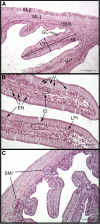Long-term feeding with high plant protein based diets in gilthead seabream (Sparus aurata, L.) leads to changes in the inflammatory and immune related gene expression at intestinal level
- PMID: 30285734
- PMCID: PMC6171182
- DOI: 10.1186/s12917-018-1626-6
Long-term feeding with high plant protein based diets in gilthead seabream (Sparus aurata, L.) leads to changes in the inflammatory and immune related gene expression at intestinal level
Abstract
Background: In order to ensure sustainability of aquaculture production of carnivourous fish species such as the gilthead seabream (Sparus aurata, L.), the impact of the inclusion of alternative protein sources to fishmeal, including plants, has been assessed. With the aim of evaluating long-term effects of vegetable diets on growth and intestinal status of the on-growing gilthead seabream (initial weight = 129 g), three experimental diets were tested: a strict plant protein-based diet (VM), a fishmeal based diet (FM) and a plant protein-based diet with 15% of marine ingredients (squid and krill meal) alternative to fishmeal (VM+). Intestines were sampled after 154 days. Besides studying growth parameters and survival, the gene expression related to inflammatory response, immune system, epithelia integrity and digestive process was analysed in the foregut and hindgut sections, as well as different histological parameters in the foregut.
Results: There were no differences in growth performance (p = 0.2703) and feed utilization (p = 0.1536), although a greater fish mortality was recorded in the VM group (p = 0.0141). In addition, this group reported a lower expression in genes related to pro-inflammatory response, as Interleukine-1β (il1β, p = 0.0415), Interleukine-6 (il6, p = 0.0347) and cyclooxigenase-2 (cox2, p = 0.0014), immune-related genes as immunoglobulin M (igm, p = 0.0002) or bacterial defence genes as alkaline phosphatase (alp, p = 0.0069). In contrast, the VM+ group yielded similar survival rate to FM (p = 0.0141) and the gene expression patterns indicated a greater induction of the inflammatory and immune markers (il1β, cox2 and igm). However, major histological changes in gut were not detected.
Conclusions: Using plants as the unique source of protein on a long term basis, replacing fishmeal in aqua feeds for gilthead seabream, may have been the reason of a decrease in the level of different pro-inflammatory mediators (il1 β, il6 and cox2) and immune-related molecules (igm and alp), which reflects a possible lack of local immune response at the intestinal mucosa, explaining the higher mortality observed. Krill and squid meal inclusion in vegetable diets, even at low concentrations, provided an improvement in nutrition and survival parameters compared to strictly plant protein based diets as VM, maybe explained by the maintenance of an effective immune response throughout the assay.
Keywords: Gene expression; Gilthead seabream; Histology; Intestine; Krill meal; Squid meal; Vegetable meal.
Conflict of interest statement
Ethics approval
The experimental protocol was reviewed and approved by the Committee of Ethics and Animal Welfare of the Universitat Politècnica de València, following the Spanish Royal Decree 53/2013 and the European Directive 2010/63/UE on the protection of animals used for scientific purposes.
Consent for publication
Not applicable.
Competing interests
The authors declare that they have no competing interests.
Publisher’s Note
Springer Nature remains neutral with regard to jurisdictional claims in published maps and institutional affiliations.
Figures




References
-
- Hardy RW. Utilization of plant proteins in fish diets: effects of global demand and supplies of fishmeal. Aquac Res. 2010;41:770–776. doi: 10.1111/j.1365-2109.2009.02349.x. - DOI
-
- Martínez-Llorens S, Moñino AV, Vidal AT, Salvador VJM, Pla Torres M, Jover Cerdá M, et al. Soybean meal as a protein source in gilthead sea bream (Sparus aurata L.) diets: effects on growth and nutrient utilization. Aquac Res. 2007;38(1):82–90. doi: 10.1111/j.1365-2109.2006.01637.x. - DOI
-
- Tacon AGJ, Metian M. Global overview on the use of fish meal and fish oil in industrially compounded aquafeeds: trends and future prospects. Aquaculture. 2008;285:146–158. doi: 10.1016/j.aquaculture.2008.08.015. - DOI
-
- Bonaldo A, Roem AJ, Fagioli P, Pecchini A, Cipollini I, Gatta PP. Influence of dietary levels of soybean meal on the performance and gut histology of gilthead sea bream (Sparus aurata L.) and European sea bass (Dicentrarchus labrax L.) Aquac Res. 2008;39(9):970–978. doi: 10.1111/j.1365-2109.2008.01958.x. - DOI
-
- Kissil G, Lupatsch I. Successful replacement of fishmeal by plant proteins in diets for the gilthead seabream, Sparus Aurata L. Isr J Aquac – Bamidgeh. 2004;56(3):188–199.
MeSH terms
Substances
Grants and funding
LinkOut - more resources
Full Text Sources
Research Materials

